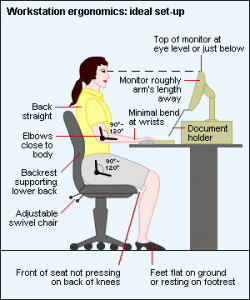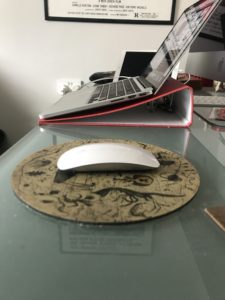With an increased amount of people working from home at the moment, I have received a lot of enquiries from patients who are struggling with back and neck pain being away from their usual workstations.
I have put together a few ideas to try to organise your work space to help you ease the pains. Got also some of my favourite stretches and mobilisations to reduce the impact from sitting in front of a computer.
While you are reading this, you will most probably be in front of a computer, on your laptop, iPad or even using your phone….now just spend a minute thinking about your posture: how are you sitting? Is your back straight or twisted to one side? Are you on a chair or slumping on a sofa with the laptop on your lap? How close are you to the screen? Are your hands on a keyboard or a mouse? How comfortable do you feel? You would probably have heard a lot about keeping a ‘good’ posture when using your computer. So what is ‘good’ posture? Well this is the usual advice: The picture below summarises some of the ‘key points of the less straining posture for your back:

- Keep the natural curves of your back, so avoid bending forward too much or ‘slumping’ on your chair. Your lower back should be in contact with the back rest of the chair, and keep your hip and pelvis on a 90-120 degree angle. So yes, it’s better to recline backwards slightly, ‘opening’ your hips.
- Knees should be around 90-100 degrees, making sure you can fit 2/3 fingers between the end of the chair and knees.
- Feet should be on the ground or on a foot rest, but never ‘dangling’.
- Elbows 90-120 degrees.
- Monitor should be arm’s length away.
- Keyboard should be fairly close to you on the table, so you can keep elbows at the right angles. The mouse should be as close to you and at the side.
I AM AT HOME AND WORKING WITH A LAPTOP
Laptops are designed to be portable, not to be ergonomically comfortable.
If you are working with a laptop the ideal is to raise the laptop on a stand, so the screen is about eyesight level, but you only would do that if you have an additional keyboard that you can connect to it, so the keyboard remains on the table.
Avoid leaning forward!

If you don’t have a stand but you have another keyboard, just raise the laptop on some books and use the spare keyboard to type.
If you don’t have an additional keyboard maybe find something that allows you to tilt the the laptop slightly, such a ring folder. This will raise the screen and tilting the keyboard should make it a bit more comfortable to use
… and I don’t have my nice office chair now…
Some of you may be currently sitting on a dining room chair or working on your kitchen table (maybe even the sofa).
First have a look at the advice I gave at the beginning and see how much you can make your current set up to mimic that as much as possible. Can you use cushions to support your lower back or to raise yourself on the chair? How can you make sure that your shoulders are not raised and your elbows relaxed? How can you avoid leaning forward?
If I had to give you two simple guidelines those would be:
- Even if you have the best chair, the most important advice is to make sure you are getting up every 20-30 mins and moving around. Setting an alarm would be ideal. Kelly Starrett in his book Deskbound, advices at least 2 mins of movement for every 30 mins of a sitting position.
- Equally you should change your posture throughout the day, maybe sitting in a different chair or working on a different table, so you make it varied, but again, no more than 20 mins.
BUT IF I SIT WITH A GOOD POSTURE, IS THAT OK?
Bad news, unfortunately, sitting is already quite a ‘straining‘ activity for our backs. In your back you have vertebrae (the bones), and discs (the softer bits in between the vertebras that allow movement in our back and they also work as shock absorbers). Discs change shape to accommodate movement in the spine. The diagram below represents two studies regarding the amount of disc pressure that 3rd/4th lower back disc can have while doing activities ranging from lying on your back to sitting down or lifting a box. So let’s say that standing straight puts 100% pressure in your disc, what is the different changes in pressure if:
-
-
-
-
-
- Standing straight: around 100%
- sitting 120 deg hips: 50%
-
-
-
- sitting slumping :175%
-
- sitting 90 deg hips: 125%
-
- lying on your back: around 25%
- lifting a 20 kg box ‘stooping’: 450%
-
-
-
-
-
-
-
So, compared with a standing posture, when you are sitting your discs are under an increased strain, and depending on how you sit, you will be putting more or less strain onto your back. It is not only the discs. Somebody who spends too long sitting, in the same posture, has more chance of straining the back and neck postural muscles, and as a result weakening the spine.
GOOD POSTURE IS A VARIABLE ONE!!
Even with the best sitting posture, prolonged sitting is really the problem, so the answer is really to keep changing posture, and not to get stuck in the same one for hours: “an ideal sitting posture is a variable one!!!” (McGill 1990)
… and what else can I do to reduce pains from sitting?
One of the advantages of being at home is that you can keep doing different stretches, without raising a few eyebrows in the office.
Maybe pick up a different stretch throughout your day, every time you break after 20-30 mins.
One of my favourite stretches is simply ‘child’s pose’ from yoga. This helps you stretch you the whole of your back and the shoulders.
If you have a foam roller at home I would use it from time to time on your upper back throughout the day. Make sure that you are supporting your neck and it does not get strained.
Stretch your chest with this simple routine using a wall or a door frame
If you feel discomfort in the neck you can try decompressing on a wall or if it feels right for you, you can try using a towel or a strength band (the guy in the video claims that it may help you to look younger, I would question that 😉
Sitting also will make your legs get tight. Try this simple stretch for the front of the leg . Also use this mobilisation for your hip to decompress it and ease your lower back.
For the back of you leg, you can stretch your hamstrings using a door frame.
So you have a few ideas to try out. If working from home has brought pain and you want some advice just drop me a message at info@centralmanchesterosteopathy.com and we can look into your specific situation.
Many thanks and stay safe!


